lock RENAULT TWINGO RS 2009 2.G Chasiss ESP Workshop Manual
[x] Cancel search | Manufacturer: RENAULT, Model Year: 2009, Model line: TWINGO RS, Model: RENAULT TWINGO RS 2009 2.GPages: 101
Page 1 of 101
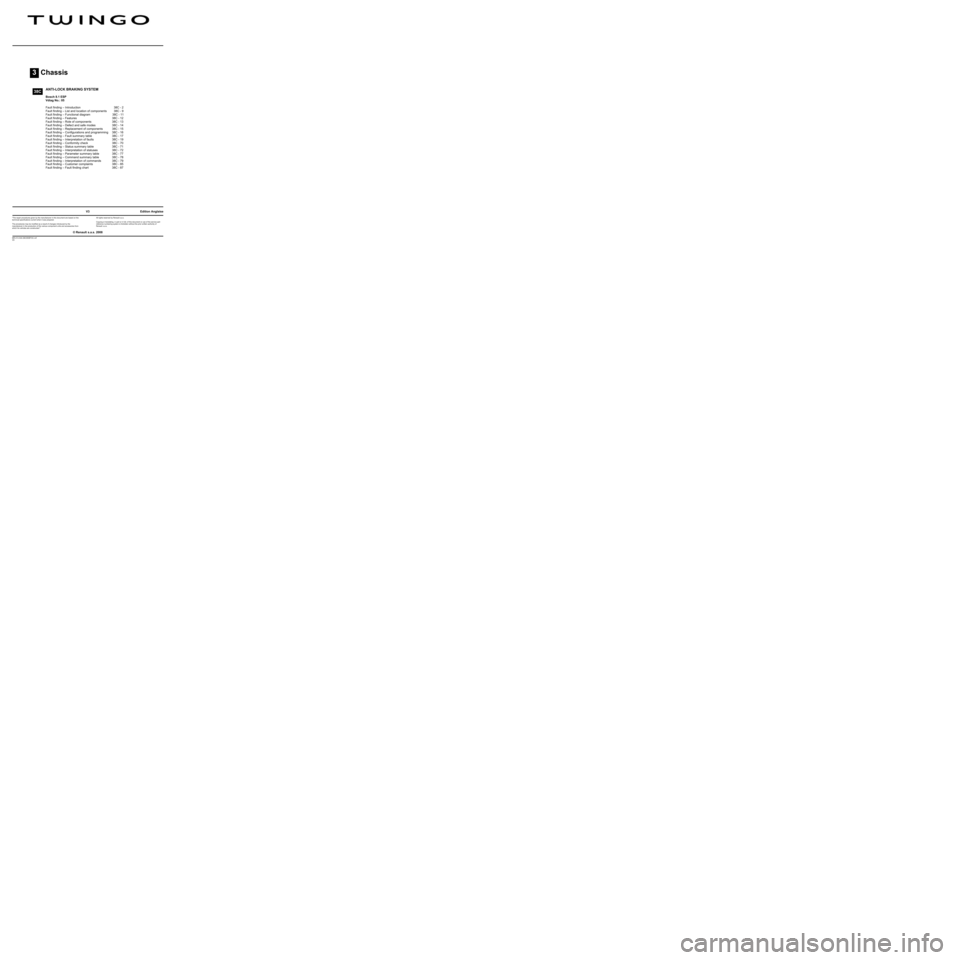
3Chassis
V3 MR-413-X44-38C050$TOC.mif
V3
38C
"The repair procedures given by the manufacturer in this document are based on the
technical specifications current when it was prepared.
The procedures may be modified as a result of changes introduced by the
manufacturer in the production of the various component units and accessories from
which his vehicles are constructed."
V3
All rights reserved by Renault s.a.s.
Edition Anglaise
Copying or translating, in part or in full, of this document or use of the service part
reference numbering system is forbidden without the prior written authority of
Renault s.a.s.
© Renault s.a.s. 2008
ANTI-LOCK BRAKING SYSTEM
Bosch 8.1 ESP
Vdiag No.: 05
Fault finding – Introduction 38C - 2
Fault finding – List and location of components 38C - 9
Fault finding – Functional diagram 38C - 11
Fault finding – Features 38C - 12
Fault finding – Role of components 38C - 13
Fault finding – Defect and safe modes 38C - 14
Fault finding – Replacement of components 38C - 15
Fault finding – Configurations and programming 38C - 16
Fault finding – Fault summary table 38C - 17
Fault finding – Interpretation of faults 38C - 19
Fault finding – Conformity check 38C - 70
Fault finding – Status summary table 38C - 71
Fault finding – Interpretation of statuses 38C - 72
Fault finding – Parameter summary table 38C - 77
Fault finding – Command summary table 38C - 78
Fault finding – Interpretation of commands 38C - 79
Fault finding – Customer complaints 38C - 85
Fault finding – Fault finding chart 38C - 87
Page 2 of 101
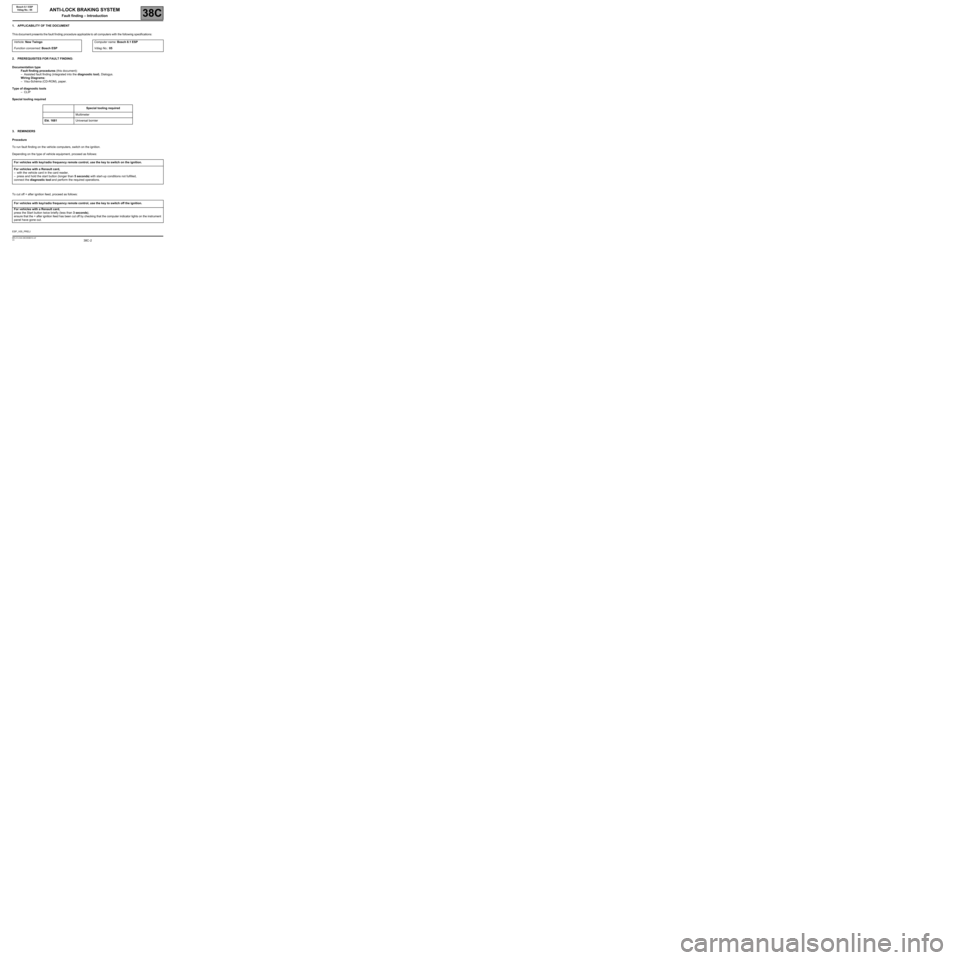
38C -2V3 MR-413-X44-38C050$010.mif
38C
Bosch 8.1 ESP
Vdiag No.: 05
1. APPLICABILITY OF THE DOCUMENT
Th is d ocument p resents the fault finding procedure applica ble to all computers with the following specifications:
2. PREREQUISITES FOR FAULT FINDING:
Documentation type
Fault finding procedures (this document):
–Assisted fault finding (integrated into the diagnostic tool), Dialogys.
Wiring Diagrams:
–Visu-Schéma (CD-ROM), paper.
Type of diagnostic tools
–CLIP
Special tooling required
3. REMINDERS
Procedure
To run fault finding on the vehicle computers, switch on the ignition.
Depending on the type of vehicle equipment, proceed as follows:
To cut off + after ignition feed, proceed as follows:Vehicle: New TwingoComputer name: Bosch 8.1 ESP
Function concerned: Bosch ESPVdiag No.: 05
Special tooling required
Multimeter
Elé. 1681Universal bornier
For vehicles with key/radio frequency remote control, use the key to switch on the ignition.
For vehicles with a Renault card,
–with the vehicle card in the card reader,
–press and hold the start button (longer than 5 seconds) with start-up conditions not fulfilled,
connect the diagnostic tool and perform the required operations.
For vehicles with key/radio frequency remote control, use the key to switch off the ignition.
For vehicles with a Renault card,
press the Start button twice briefly (less than 3 seconds),
ensure that the + after ignition feed has been cut off by checking that the computer indicator lights on the instrument
panel have gone out.
ESP_V05_PRELI
ANTI-LOCK BRAKING SYSTEM
Fault finding – Introduction
Page 3 of 101
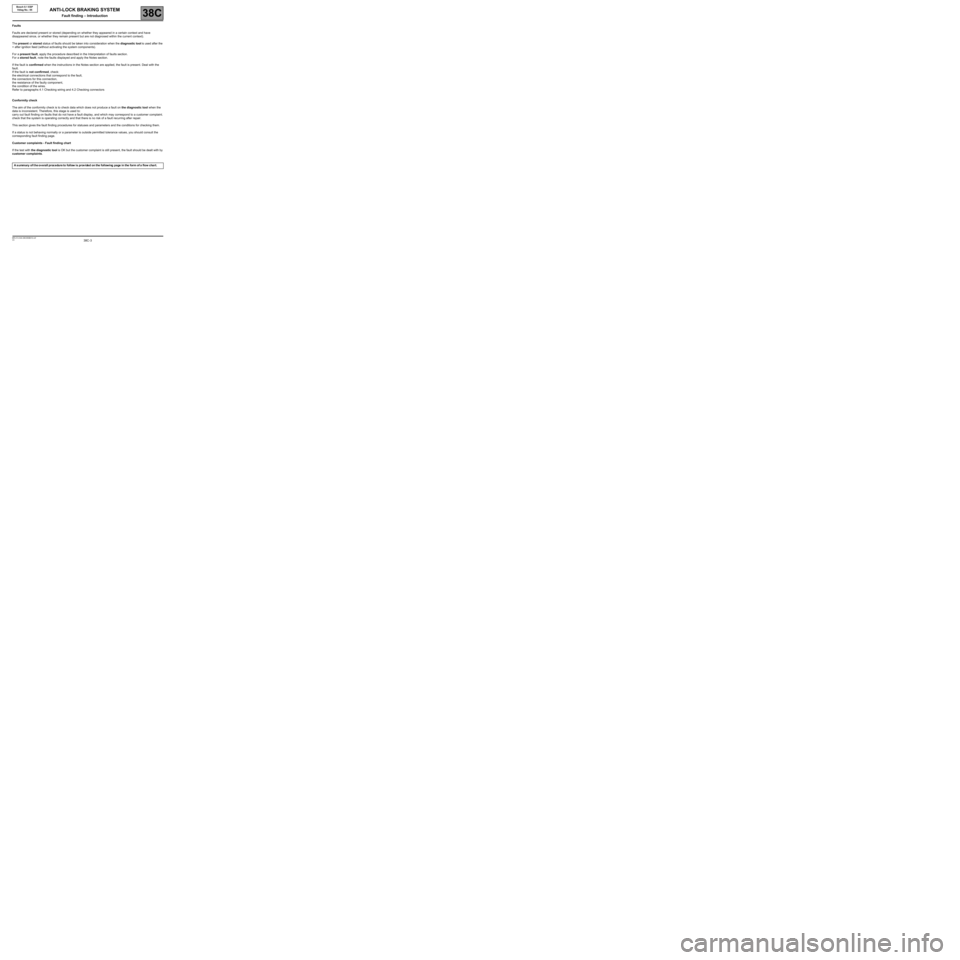
38C -3V3 MR-413-X44-38C050$010.mif
ANTI-LOCK BRAKING SYSTEM
Fault finding – Introduction
Bosch 8.1 ESP
Vdiag No.: 05
38C
Faults
Faults are declared present or stored (depending on whether they appeared in a certain context and have
disappeared since, or whether they remain present but are not diagnosed within the current context).
The present or stored status of faults should be taken into consideration when the diagnostic tool is used after the
+ after ignition feed (without activating the system components).
For a present fault, apply the procedure described in the Interpretation of faults section.
For a stored fault, note the faults displayed and apply the Notes section.
If the fault is confirmed when the instructions in the Notes section are applied, the fault is present. Deal with the
fault.
If the fault is not confirmed, check:
the electrical connections that correspond to the fault,
the connectors for this connection,
the resistance of the faulty component,
the condition of the wires.
Refer to paragraphs 4.1 Checking wiring and 4.2 Checking connectors
Conformity check
The aim of the conformity check is to check data which does not produce a fault on the diagnostic tool when the
data is inconsistent. Therefore, this stage is used to:
carry out fault finding on faults that do not have a fault display, and which may correspond to a customer complaint.
check that the system is operating correctly and that there is no risk of a fault recurring after repair.
This section gives the fault finding procedures for statuses and parameters and the conditions for checking them.
If a status is not behaving normally or a parameter is outside permitted tolerance values, you should consult the
corresponding fault finding page.
Customer complaints - Fault finding chart
If the test with the diagnostic tool is OK but the customer complaint is still present, the fault should be dealt with by
customer complaints.
Asummary oftheoverall proc edure to follow isprovidedonthe fol lowing page in the form of a flow chart.
Page 4 of 101
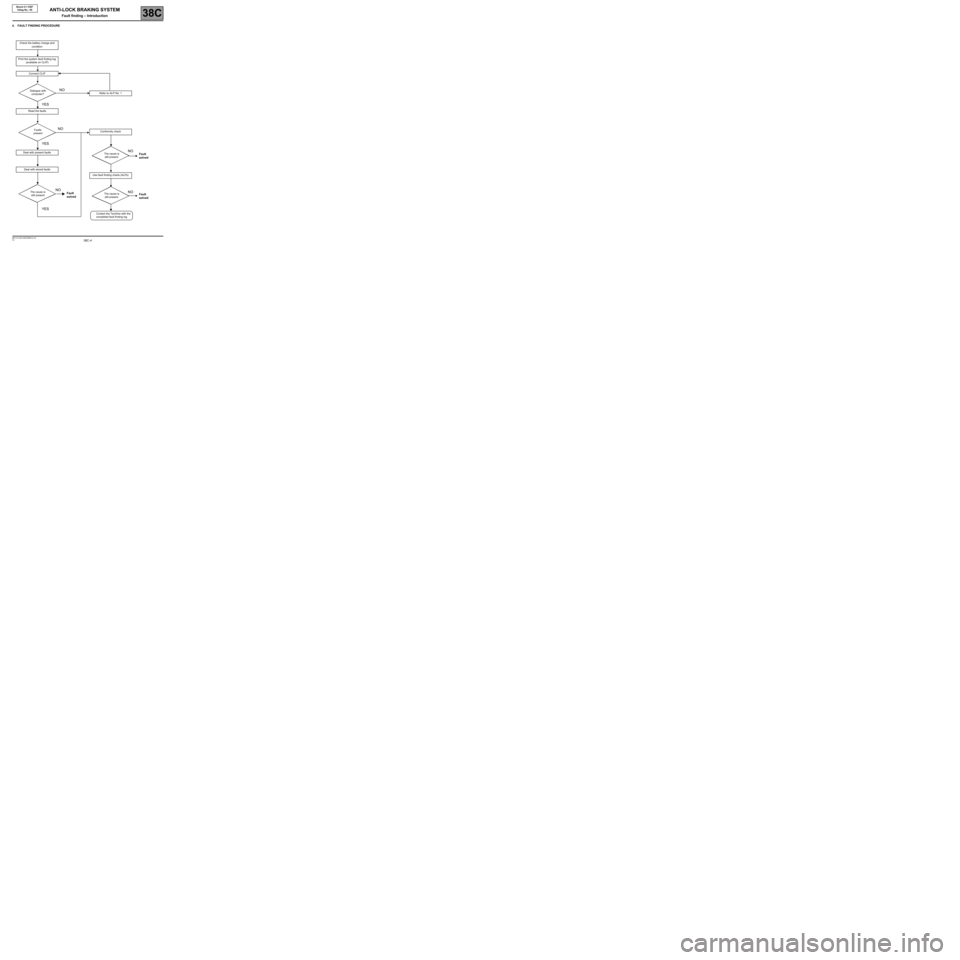
38C -4V3 MR-413-X44-38C050$010.mif
ANTI-LOCK BRAKING SYSTEM
Fault finding – Introduction
Bosch 8.1 ESP
Vdiag No.: 05
38C
4. FAULT FINDING PROCEDURE
Check the battery charge and
condition
Print the system fault finding log
(available on CLIP)
Connect CLIP
Refer to ALP No. 1
Read the faults
Deal with present faults
Deal with stored faults
Conformity check
Use fault finding charts (ALPs)
Dialogue with
computer?
Faults
present
The cause is
still present
The cause is
still presentThe cause is
still present
Contact the Techline with the
completed fault finding log
NO
NONO
NO NO
YES
YES
YES
Fault
solvedFault
solved Fault
solved
Page 5 of 101
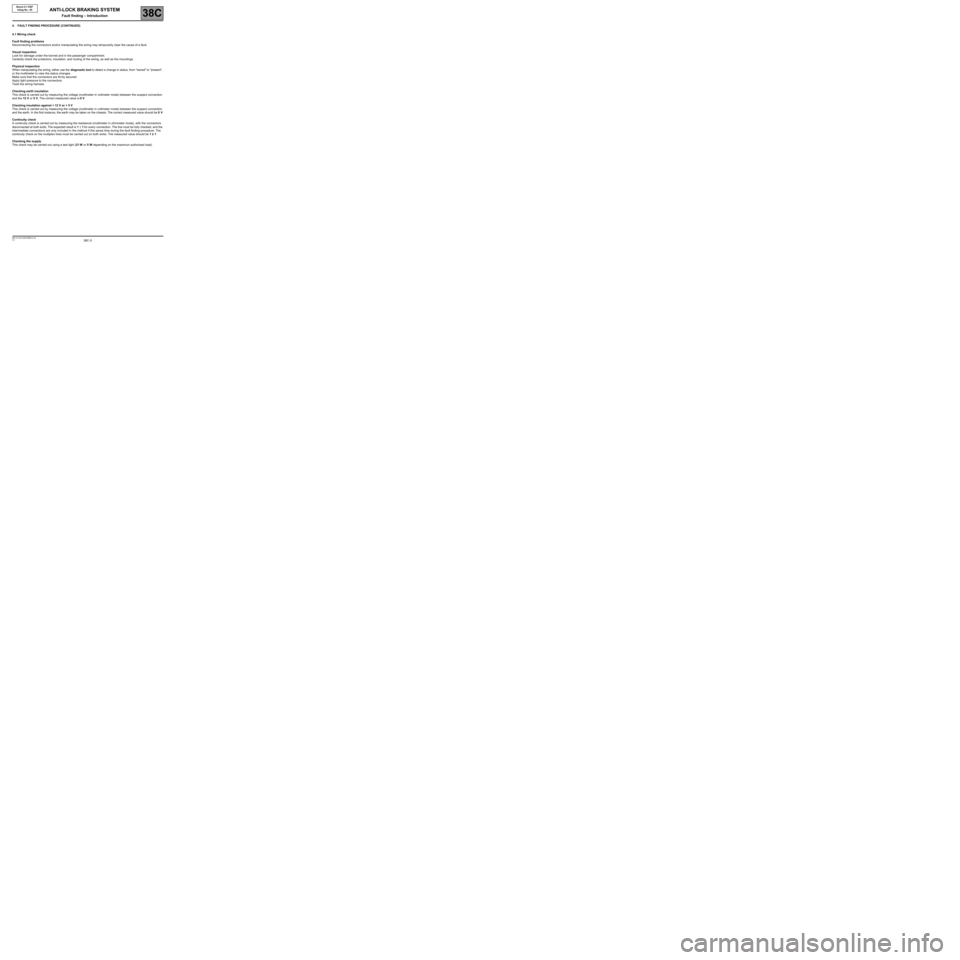
38C -5V3 MR-413-X44-38C050$010.mif
ANTI-LOCK BRAKING SYSTEM
Fault finding – Introduction
Bosch 8.1 ESP
Vdiag No.: 05
38C
4. FAULT FINDING PROCEDURE (CONTINUED)
4.1 Wiring check
Fault finding problems
Disconnecting the connectors and/or manipulating the wiring may temporarily clear the cause of a fault.
Visual inspection
Look for damage under the bonnet and in the passenger compartment.
Carefully check the protectors, insulation, and routing of the wiring, as well as the mountings.
Physical inspection
When manipulating the wiring, either use the diagnostic tool to detect a change in status, from "stored" to "present",
or the multimeter to view the status changes.
Make sure that the connectors are firmly secured.
Apply light pressure to the connectors.
Twist the wiring harness.
Checking earth insulation
This check is carried out by measuring the voltage (multimeter in voltmeter mode) between the suspect connection
and the 12 V or 5 V. The correct measured value is 0 V.
Checking insulation against + 12 V or + 5 V
This check is carried out by measuring the voltage (multimeter in voltmeter mode) between the suspect connection
and the earth. In the first instance, the earth may be taken on the chassis. The correct measured value should be 0 V
Continuity check
A continuity check is carried out by measuring the resistance (multimeter in ohmmeter mode), with the connectors
disconnected at both ends. The expected result is 1
± 1 for every connection. The line must be fully checked, and the
intermediate connections are only included in the method if this saves time during the fault finding procedure. The
continuity check on the multiplex lines must be carried out on both wires. The measured value should be 1 ± 1.
Checking the supply
This check may be carried out using a test light (21 W or 5 W depending on the maximum authorised load).
Page 6 of 101
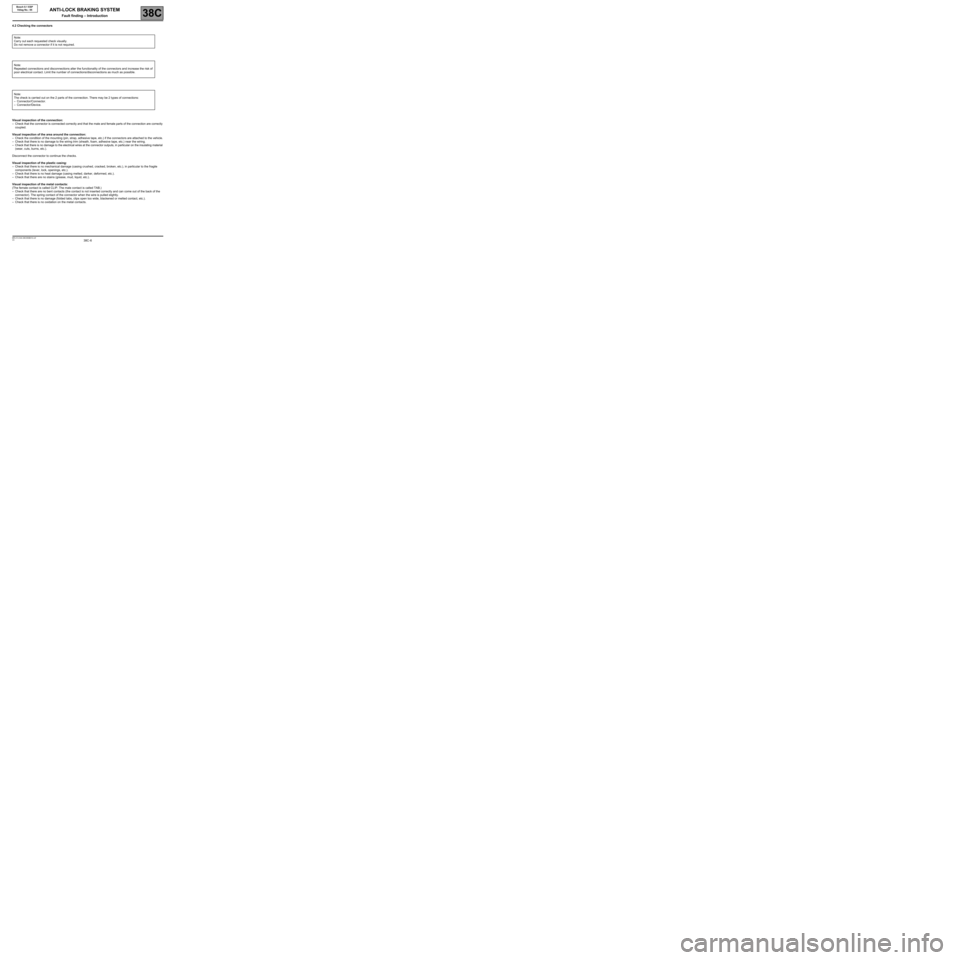
38C -6V3 MR-413-X44-38C050$010.mif
ANTI-LOCK BRAKING SYSTEM
Fault finding – Introduction
Bosch 8.1 ESP
Vdiag No.: 05
38C
4.2 Checking the connectors
Visual inspection of the connection:
–Check that the connector is connected correctly and that the male and female parts of the connection are correctly
coupled.
Visual inspection of the area around the connection:
–Check the condition of the mounting (pin, strap, adhesive tape, etc.) if the connectors are attached to the vehicle.
–Check that there is no damage to the wiring trim (sheath, foam, adhesive tape, etc.) near the wiring.
–Check that there is no damage to the electrical wires at the connector outputs, in particular on the insulating material
(wear, cuts, burns, etc.).
Disconnect the connector to continue the checks.
Visual inspection of the plastic casing:
–Check that there is no mechanical damage (casing crushed, cracked, broken, etc.), in particular to the fragile
components (lever, lock, openings, etc.).
–Check that there is no heat damage (casing melted, darker, deformed, etc.).
–Check that there are no stains (grease, mud, liquid, etc.).
Visual inspection of the metal contacts:
(The female contact is called CLIP. The male contact is called TAB.)
–Check that there are no bent contacts (the contact is not inserted correctly and can come out of the back of the
connector). The spring contact of the connector when the wire is pulled slightly.
–Check that there is no damage (folded tabs, clips open too wide, blackened or melted contact, etc.).
–Check that there is no oxidation on the metal contacts. Note:
Carry out each requested check visually.
Do not remove a connector if it is not required.
Note:
Repeated connections and disconnections alter the functionality of the connectors and increase the risk of
poor electrical contact. Limit the number of connections/disconnections as much as possible.
Note:
The check is carried out on the 2 parts of the connection. There may be 2 types of connections:
–Connector/Connector.
–Connector/Device.
Page 7 of 101
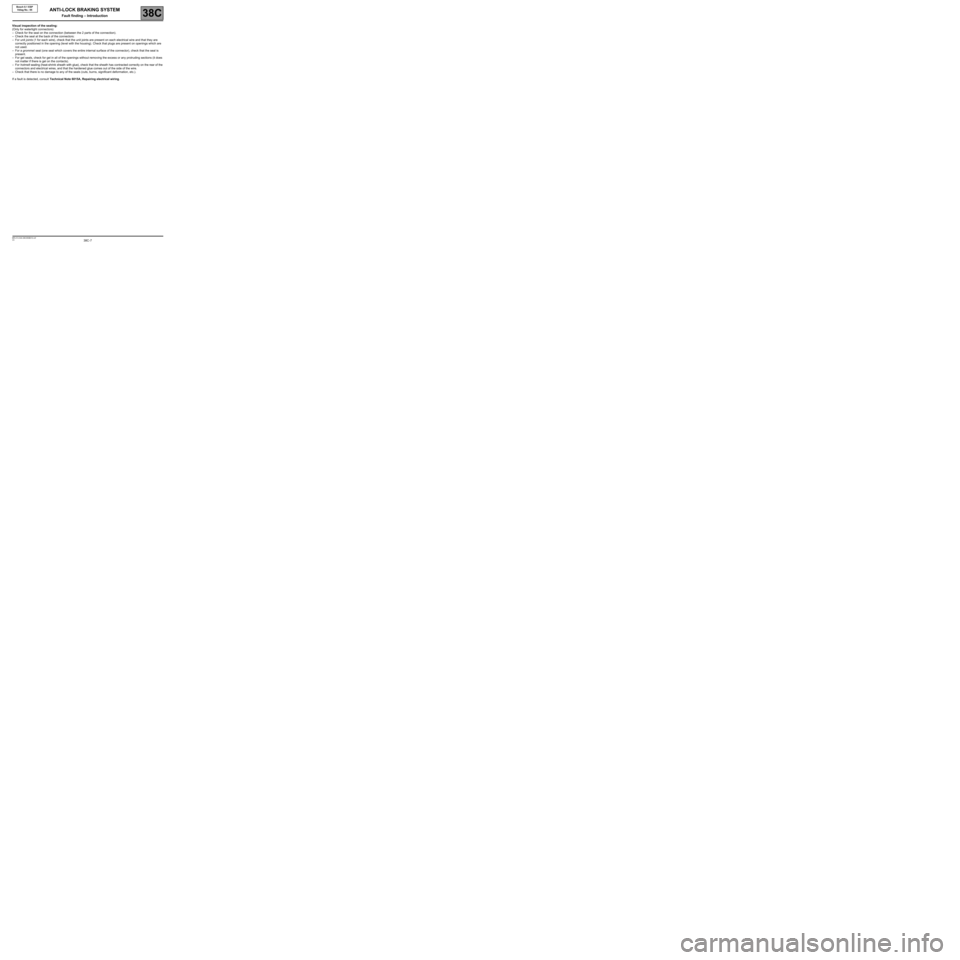
38C -7V3 MR-413-X44-38C050$010.mif
ANTI-LOCK BRAKING SYSTEM
Fault finding – Introduction
Bosch 8.1 ESP
Vdiag No.: 05
38C
Visual inspection of the sealing:
(Only for watertight connectors)
–Check for the seal on the connection (between the 2 parts of the connection).
–Check the seal at the back of the connectors:
–For unit joints (1 for each wire), check that the unit joints are present on each electrical wire and that they are
correctly positioned in the opening (level with the housing). Check that plugs are present on openings which are
not used.
–For a grommet seal (one seal which covers the entire internal surface of the connector), check that the seal is
present.
–For gel seals, check for gel in all of the openings without removing the excess or any protruding sections (it does
not matter if there is gel on the contacts).
–For hotmelt sealing (heat-shrink sheath with glue), check that the sheath has contracted correctly on the rear of the
connectors and electrical wires, and that the hardened glue comes out of the side of the wire.
–Check that there is no damage to any of the seals (cuts, burns, significant deformation, etc.).
If a fault is detected, consult Technical Note 6015A, Repairing electrical wiring.
Page 8 of 101
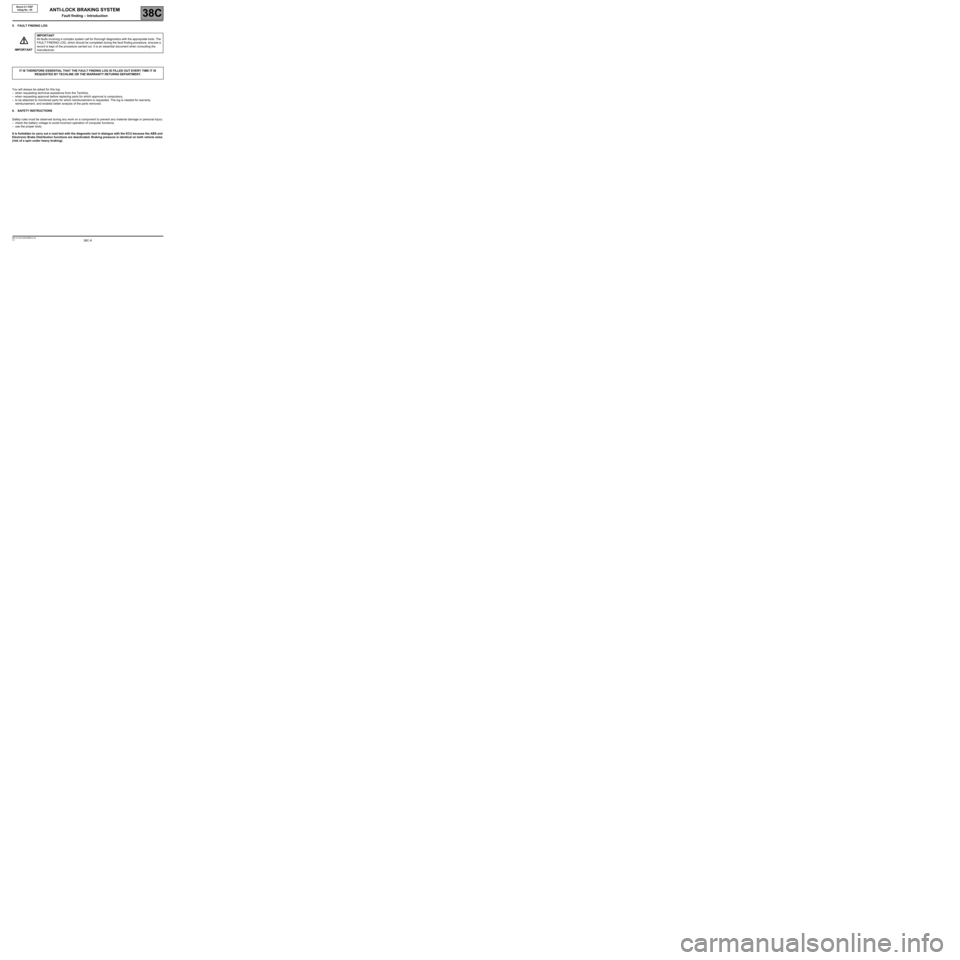
38C -8V3 MR-413-X44-38C050$010.mif
ANTI-LOCK BRAKING SYSTEM
Fault finding – Introduction
Bosch 8.1 ESP
Vdiag No.: 05
38C
5. FAULT FINDING LOG
You will always be asked for this log:
–when requesting technical assistance from the Techline,
–when requesting approval before replacing parts for which approval is compulsory,
–to be attached to monitored parts for which reimbursement is requested. The log is needed for warranty
reimbursement, and enables better analysis of the parts removed.
6. SAFETY INSTRUCTIONS
Safety rules must be observed during any work on a component to prevent any material damage or personal injury:
–check the battery voltage to avoid incorrect operation of computer functions,
–use the proper tools.
It is forbidden to carry out a road test with the diagnostic tool in dialogue with the ECU because the ABS and
Electronic Brake Distribution functions are deactivated. Braking pressure is identical on both vehicle axles
(risk of a spin under heavy braking).IMPORTANTIMPORTANT
All faults involving a complex system call for thorough diagnostics with the appropriate tools. The
FAULT FINDING LOG, which should be completed during the fault finding procedure, ensures a
record is kept of the procedure carried out. It is an essential document when consulting the
manufacturer.
IT IS THEREFORE ESSENTIAL THAT THE FAULT FINDING LOG IS FILLED OUT EVERY TIME IT IS
REQUESTED BY TECHLINE OR THE WARRANTY RETURNS DEPARTMENT.
Page 9 of 101
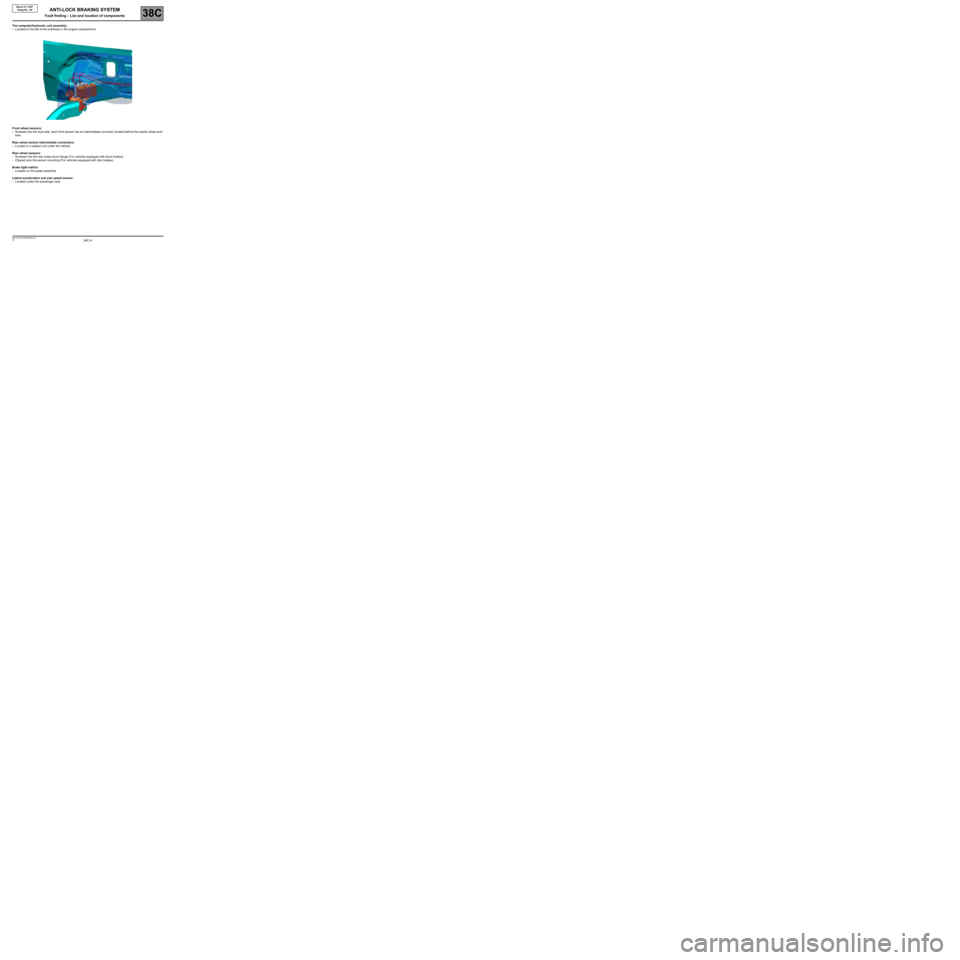
38C -9V3 MR-413-X44-38C050$020.mif
Bosch 8.1 ESP
Vdiag No.: 05
38C
The computer/hydraulic unit assembly:
–Located to the left of the bulkhead in the engine compartment.
Front wheel sensors:
–Screwed into the stub-axle, each front sensor has an intermediate connector located behind the plastic wheel arch
liner.
Rear wheel sensor intermediate connectors:
–Located in a sealed unit under the vehicle.
Rear wheel sensors:
–Screwed into the rear brake drum flange (For vehicles equipped with drum brakes).
–Clipped onto the sensor mounting (For vehicles equipped with disc brakes).
Brake light switch:
–Located on the pedal assembly.
Lateral acceleration and yaw speed sensor:
–Located under the passenger seat
ANTI-LOCK BRAKING SYSTEM
Fault finding – List and location of components
Page 10 of 101

38C-10V3 MR-413-X44-38C050$020.mif
ANTI-LOCK BRAKING SYSTEM
Fault finding – List and location of components
Bosch 8.1 ESP
Vdiag No.: 05
38C
Steering wheel angle sensor:
–Located on the steering column, on the intermediate shaft side.